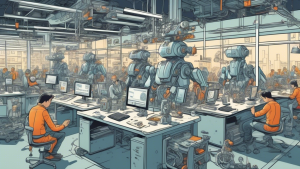In the digital age, where efficiency and speed are paramount, customer service has undergone a significant transformation powered by automation. The revolutionaries of this change—technologies like AI, chatbots, and automated call centers—promise to reshape how businesses interact with their customers. But as we march towards this automated future, a critical question arises: Can robots really make customers happy?
The story of automation in customer service is a saga of constant evolution. From the early days of phone menus and basic email responders to today’s sophisticated AI-driven chatbots and virtual assistants, the goal has always been clear—improve customer interactions while reducing operational costs. Modern innovations, leveraging machine learning and natural language processing, can now understand and respond to queries with human-like precision. Companies from various sectors have dived headfirst into this realm, implementing cutting-edge solutions with impressive results. Case studies reveal patterns of enhanced efficiency and higher customer engagement, painting a promising picture.
However, the real test lies in how these automated tools affect customer satisfaction. Metrics and data collection play a crucial role in this evaluation, giving businesses insights into how their automated systems are performing. And the benefits? From round-the-clock service to personalized and faster responses, automation offers substantial advantages. But it’s not without challenges. The lack of human touch and empathy in automated systems can be a significant hurdle. As businesses strive for a balance, integrating the warmth of human interaction with the relentless efficiency of robots, the ultimate goal remains unchanged—to make customers happy.
So, will the future of customer service see a new era where robots reign supreme, or will the human touch always hold its ground? As we delve deeper into the world of automated customer service, the answer might surprise you. Join us as we explore the fascinating intersection of automation and customer satisfaction.
The Rise of Automation in Customer Service
Understanding the Evolution of Customer Service Automation
Automation in customer service has come a long way from its early days. In the past, customer service primarily involved human operators fielding phone calls. However, as technology advanced, businesses began to adopt automated solutions to handle increasing customer demands. Initially, automation was limited to simple tasks like ticketing and email responses. But over time, we’ve seen a transition to more sophisticated systems that can handle complex interactions.
The evolution began with basic Interactive Voice Response (IVR) systems. These systems allowed customers to navigate through automated menus using their phone keypad or voice commands. While IVR systems were an improvement, they often left customers frustrated due to their rigid and limited options.
The next significant milestone was the introduction of chatbots and virtual assistants. Unlike IVR, chatbots could communicate in natural language and handle more nuanced queries. This leap was made possible by advancements in Natural Language Processing (NLP) and Machine Learning (ML). Essentially, these technologies enable the bots to understand and interpret human language, providing more accurate and helpful responses.
Today, customer service automation encompasses a broad spectrum of technologies. Each development has brought us closer to a seamless customer experience, capable of meeting the demands of a dynamic marketplace. As we delve into key technologies driving this revolution, the benefits of automation become increasingly evident.
Key Technologies Driving Automated Customer Interactions
Several cutting-edge technologies underpin modern automated customer service solutions:
1. Natural Language Processing (NLP): This technology allows computers to understand, interpret, and respond to human language in a natural and meaningful way. It’s the backbone of chatbots and virtual assistants, enabling them to hold conversations that feel more human.
2. Machine Learning (ML): ML algorithms help systems learn from data, improving their performance over time. In customer service, ML can be used to predict customer needs, personalize responses, and even identify issues before they become problems.
3. Artificial Intelligence (AI): AI encompasses a range of technologies, including NLP and ML, but also others like computer vision and robotics. In customer service, AI can be used to analyze enormous amounts of data to uncover insights and forecast trends.
4. Automation Software: Platforms like RPA (Robotic Process Automation) automate repetitive, rule-based tasks. This allows human agents to focus on more complex and meaningful interactions, improving overall efficiency.
5. Sentiment Analysis: By analyzing the tone and context of customer interactions, sentiment analysis software can gauge customer emotions. This helps businesses quickly address dissatisfaction and enhance positive experiences.
These technologies work in tandem, creating a robust framework for automated customer service systems. By leveraging these advancements, companies can minimize response times, reduce operational costs, and elevate the customer experience.
Case Studies: Successful Implementation of Automated Customer Service Solutions
To really appreciate the impact of these technologies, it’s helpful to look at some real-world examples of successful implementation:
1. Bank of America’s Erica: Bank of America launched Erica, an AI-driven virtual assistant, to provide customers with a more efficient banking experience. Erica leverages NLP, ML, and AI to help with tasks such as checking balances, transferring money, and providing financial insights. Since its introduction, Erica has managed millions of client requests, demonstrating the power of automation in streamlining complex banking operations while enhancing user satisfaction.
2. Amazon’s Alexa: Alexa, Amazon’s virtual assistant, has revolutionized customer service by providing immediate responses to customer queries. Through constant learning and integration with various services, Alexa can assist users in managing their shopping lists, controlling smart home devices, and providing personalized recommendations. The level of automation offered by Alexa not only boosts customer convenience but also supports Amazon’s broader ecosystem.
3. Sephora’s Chatbots: The beauty retailer Sephora employs chatbots on their website and mobile app to assist customers in product selection and provide personalized makeup tips. By analyzing users’ preferences and previous purchases, these chatbots offer tailored advice, creating a more engaging and satisfying shopping experience. This implementation has resulted in higher customer engagement and improved sales conversions.
4. H&M’s Digital Clerk: The global clothing retailer H&M uses an AI-driven chatbot to enhance online shopping. This virtual assistant helps customers find items based on past purchases, current trends, and even social media fashion posts. The chatbot not only improves user interaction but also boosts cross-selling and upselling opportunities.
5. Starbucks’ Mobile Order & Pay: Starbucks has integrated automation into their mobile app, allowing customers to place orders and make payments seamlessly. The app uses AI to recommend drinks based on past orders, seasonal preferences, and even weather conditions. This level of personalization has led to a smoother, faster customer experience, and increased app usage.
These case studies highlight that with the right implementation, automation can lead to significant enhancements in customer service. By addressing routine queries efficiently and personalizing interactions, these companies have managed to increase customer satisfaction and loyalty.
In summation, the rise of automation in customer service is a testament to the relentless pursuit of efficiency and customer satisfaction. From the early days of IVR systems to the sophisticated AI and ML-driven solutions of today, the journey has been remarkable. The ability to harness these advanced technologies has empowered businesses to provide quicker, more accurate, and highly personalized customer interactions. Through real-world examples, we see that automation, when executed correctly, is not just a cost-saving measure but a powerful tool to foster customer happiness.

Impact on Customer Satisfaction
Measuring Customer Satisfaction in the Age of Automation
Understanding how satisfied customers are with automated services is crucial. Businesses typically measure this through surveys, feedback forms, and analytics. Each of these methods provides valuable insights into how customers feel about their interaction with automated systems.
Surveys can be conducted immediately after an automated interaction, asking customers to rate their experience. Questions might include how easy it was to get information, how quickly their issue was resolved, and their overall satisfaction with the service. These surveys can be short and to the point, usually on a scale from 1 to 5.
Feedback forms are often more detailed, allowing customers to elaborate on their experiences. They might highlight areas for improvement that automated systems can address in future updates. Businesses can use this feedback to tweak scripts, enhance natural language understanding, or resolve common issues that the automated system might not handle well.
Analytics is another powerful tool. By tracking metrics such as response time, resolution rate, and customer dropout rates, companies can see how well their automated systems are working. For instance, if a lot of customers abandon a chatbot conversation mid-way, it might indicate a problem with the bot’s logic or ability to understand user queries.
Benefits of Automation for Enhancing Customer Experience
Automation offers several significant advantages that can enhance the customer experience. Below are some key benefits:
- 24/7 Availability: Automated systems like chatbots don’t need sleep. They can assist customers any time of the day or night. This round-the-clock availability ensures that customers don’t have to wait for business hours to get help.
- Quick Response Times: Automated systems can process information and respond almost instantly. This eliminates the frustrating wait times that many customers experience with human agents, especially during peak hours.
- Consistency: Automation removes the variability that can come with human agents. Each customer gets the same level of service, and there’s less risk of errors or overlooked issues.
- Handling High Volumes: Automated systems can manage thousands of queries simultaneously, something human agents can’t do. This scalability is especially useful during high-traffic periods.
- Cost-Efficiency: While there’s an upfront cost in developing automated systems, they can save businesses a lot of money in the long run by reducing the need for large customer service teams.
- Personalization: Advanced automated systems can use data to provide a personalized experience. For example, they can greet customers by name, offer product recommendations based on past purchases, and remember previous interactions.
Each of these advantages contributes to a more efficient, satisfying customer experience and makes the case for incorporating automation into customer service strategies.
Addressing Challenges: Human Touch in Automated Customer Service
Despite the many advantages, automation in customer service isn’t without its challenges. One of the biggest concerns is the lack of human touch that can sometimes make automated interactions feel cold and impersonal.
To address this challenge, businesses can adopt a few strategies to ensure customers still feel valued and understood:
- Hybrid Systems: Combining automated systems with human agents can offer the best of both worlds. For instance, a chatbot can handle simple queries and direct more complex issues to a human representative.
- Escalation Paths: Ensure that there are clear and easy ways for customers to escalate their issues from an automated system to a human agent. This can prevent frustration if the automated system can’t handle their specific problem.
- Empathy in Design: When designing automated interactions, it’s important to program responses that acknowledge customer emotions. Simple phrases like I understand your frustration or Let me help you with that can make a big difference.
- Regular Updates: Automated systems should continually learn and evolve from customer interactions. Regular updates can help these systems improve their responses and become more accurate and helpful over time.
- Personalized Follow-ups: After an interaction with an automated system, a follow-up from a human agent can help reinforce that personal touch. This could be a simple email or a quick phone call to ensure the customer’s issue was fully resolved.
By addressing these challenges, businesses can ensure their automated customer service systems not only improve efficiency but also keep customers satisfied and engaged.
In pondering the pivotal question, Can robots make customers happy?, we find ourselves at the intersection of technological innovation and human need. The rise of automation in customer service is a compelling narrative of evolution, where key technologies such as artificial intelligence (AI), machine learning, and chatbots have taken center stage. Through these advancements, businesses have managed to efficiently streamline customer interactions, as seen in numerous successful case studies.
While the deployment of automation in customer service offers a myriad of benefits, such as 24/7 availability, faster response times, and consistent service, its impact on customer satisfaction isn’t solely a matter of increased efficiency. Customer satisfaction in this automated age hinges on whether these systems can meet—and exceed—expectations traditionally catered to by human agents.
Metrics for gauging satisfaction reveal that well-implemented automated solutions boost overall customer experience. For example, reduced wait times and quick resolutions to common inquiries lead to higher satisfaction ratings. However, the equation is not without its variables; the absence of human empathy and understanding in purely robotic interactions can be a sticking point. Clients can become frustrated when dealing with issues that require a nuanced human touch or when navigating overly scripted responses that lack flexibility.
Addressing this challenge involves integrating a seamless human-robot synergy. Automation should handle routine, repetitive tasks efficiently, allowing human agents to focus on complex, emotion-driven issues where empathy and personalized interaction are irreplaceable. This hybrid approach can provide the best of both worlds, leveraging the speed and precision of automation while retaining the emotional intelligence and adaptability of human service.
In conclusion, robotics and automation have a promising role in enhancing customer satisfaction. The key is a strategic implementation that recognizes the strengths of both automated systems and human agents. When done correctly, businesses not only optimize operations but also ensure that customers feel valued and understood, ultimately leading to increased happiness and loyalty. By balancing technological efficiency with genuine human interaction, businesses are poised to make their customers not just satisfied, but truly happy.






No comments! Be the first commenter?